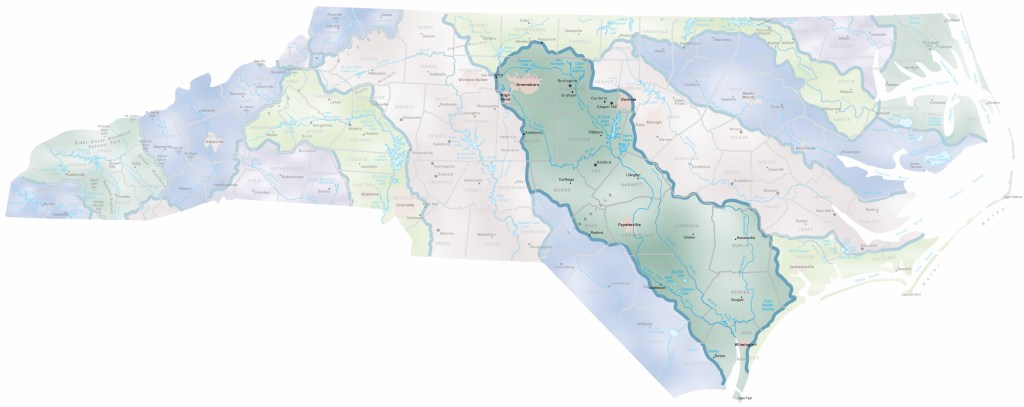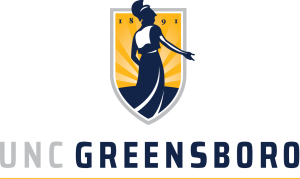Funded by the “Humanities Initiatives” of the National Endowment for the Humanities (2022-24)
The Cape Fear Watershed Project (CFWP) uses the humanities to connect natural- and social-science studies of a major bioregion of North Carolina. Our environmental humanities initiative emphasizes collaborative, place-based interdisciplinary teaching with benefits for graduate and undergraduate students together with our watershed communities.
Watersheds provide a natural organizing principle to study people and places: they integrate space, time, biophysical systems, and humans, while also encompassing the complex interactions of biophysical and social systems. The Cape Fear River is one example of how people interact with place: its watershed (the only major one entirely within North Carolina) offers opportunities to explore topics concerning human interactions with the environment and social manifestations related to place. The CFWP uses the watershed to reflect on social connections and human relationships in and with nature, all with the aim of creating a shared sense of community that leads to greater responsibility for the human and non-human life in our region.

[Click image to enlarge] Map overview of the Cape Fear River Watershed. Greensboro is situated between the headwaters of the Haw and Deep Rivers. The Cape Fear River originates at their confluence, beginning its 200-mile journey to Wilmington and the Atlantic Ocean.
Focusing initially on the online M.S. in Sustainability & Environment (MSSE), we will integrate environmental humanities practices in numerous courses in order to achieve our overarching goal: unifying the MSSE curriculum via the theme of the Cape Fear Watershed (CFW). Specifically, the CFWP will:
The CFWP uses humanities methods (e.g., history, ethics, reflection, creativity, etc.) to craft a model curriculum regarding topics (places, environments, watersheds) that are normally the purview of the physical, natural, and social sciences. Moreover, the CFWP focuses on specific places in North Carolina via an online program, both to improve the educational outcomes and to increase the sense of community among students and between students and faculty. After developing these programs and curricula for the MSSE, we plan to adapt them for the B.A. in Environment & Sustainability and to share them with other institutions.
Read more about the CFWP in this UNCG News article.
We held our first B2B Workshop in May 2023.
Our MS students participated in the first offering of our field course in May 2024.
The CFWP is led by UNC Greensboro in collaboration with UNC Wilmington and institutional partners in the watershed (listed below). To illustrate our core faculty members’ interdisciplinarity, we use the Environment & Sustainability Program’s logo of the four-leaf sustainability clover to organize our members by last name: the top left (largest) leaf represents environment, while the top right illustrates aesthetics (humanities); the bottom right is development and economics, while bottom left is social justice:

In addition to these faculty and staff from UNCG and UNCW, the CFWP welcomes guests who observe and participate. Furthermore, the CFWP is proud to collaborate with organizations whose work focuses on the Cape Fear watershed. These include Cape Fear River Watch, Carolina Wetlands Association, Haw River Assembly, the Piedmont Conservation Council, and the Bingham Park Justice Project. We are pleased also to connect our work with the national River Studies Field Network.
Aaron S. Allen (PI, UNCG, Music / GES)
Risa Applegarth (UNCG, English)
Osku Backstrom (UNCW, Environmental Sciences)
Plaxedes Chitiyo (UNCG, GES)
Devon Eulie (UNCW, Environmental Sciences)
Marcia Hale (UNCG, Peace & Conflict Studies)
Etsuko Kinefuchi (UNCG, Communication Studies / GES)
Greg O’Brien (UNCG, History)
Sarah Praskievicz (UNCG, GES)
Nathan Rector (UNCG, GES)
Roger Shew (UNCW, Environmental Sciences / Earth & Ocean Sciences)
Derek Skillings (UNCG, Philosophy)
Ann Berry Somers (UNCG, Biology / GES)
John Stehlin (UNCG, GES)
Emeriti Team Members:
StoryMaps, a product of the GIS company ESRI, are interactive web maps that allow for virtual “tours” of a mapped landscape, integrated with text, photos, and videos. The ability to integrate literary and artistic content with spatial data allows for humanities content to be linked to place, the overarching goal of the CFWP. Accessible to anyone, StoryMaps will be a living resource for faculty, students, and the public that is continually developed and expanded. To follow the progress of the CFWP, visit our StoryMap.
Click here to view our reading list and supplementary bibliography. We will all be reading and discussing Philip Gerard’s Down the Wild Cape Fear: A River Journey Through the Heart of North Carolina (University of North Carolina Press, 2013).
Click here to read an UNCG News article (June 2022) about the Project.
Further links:

